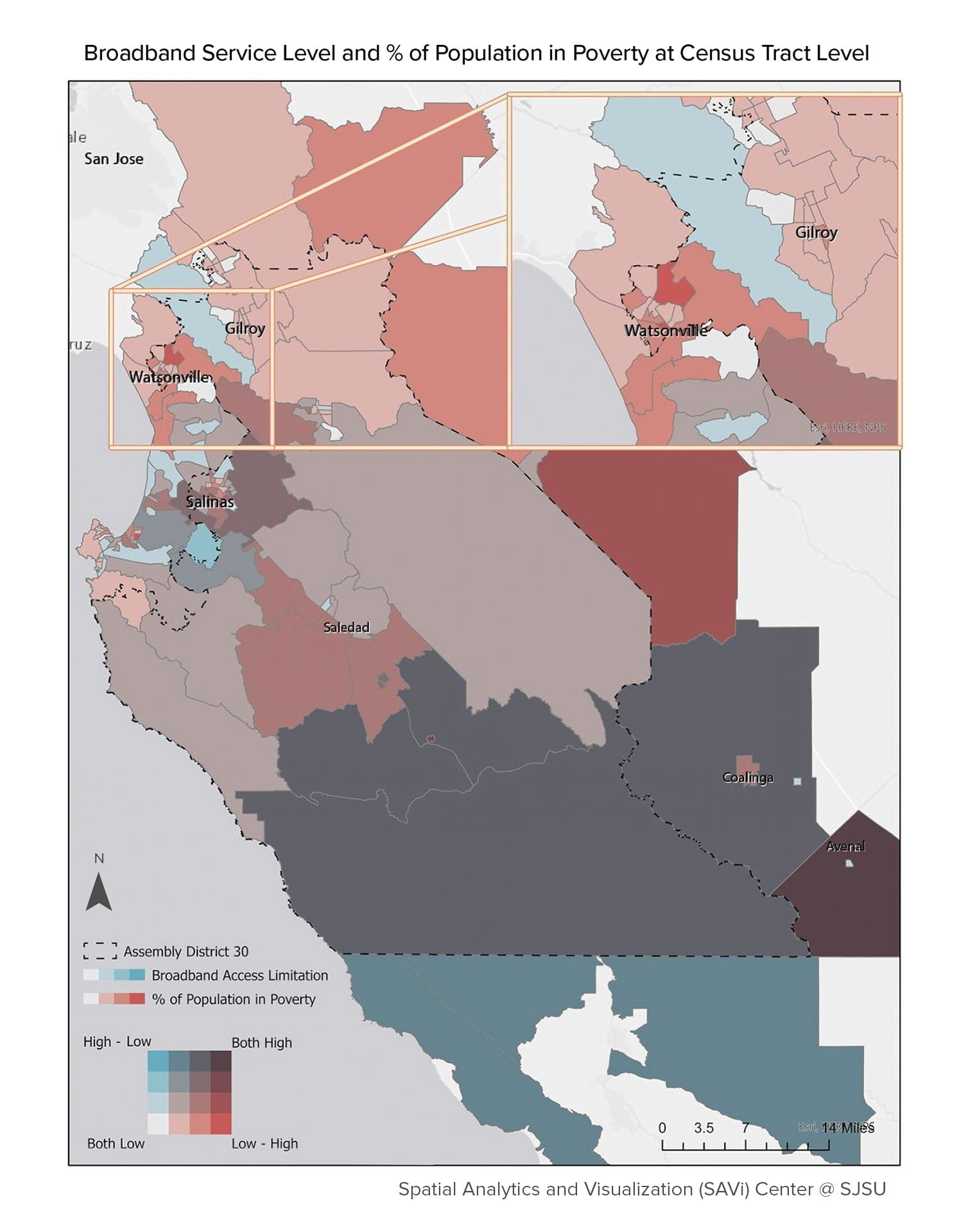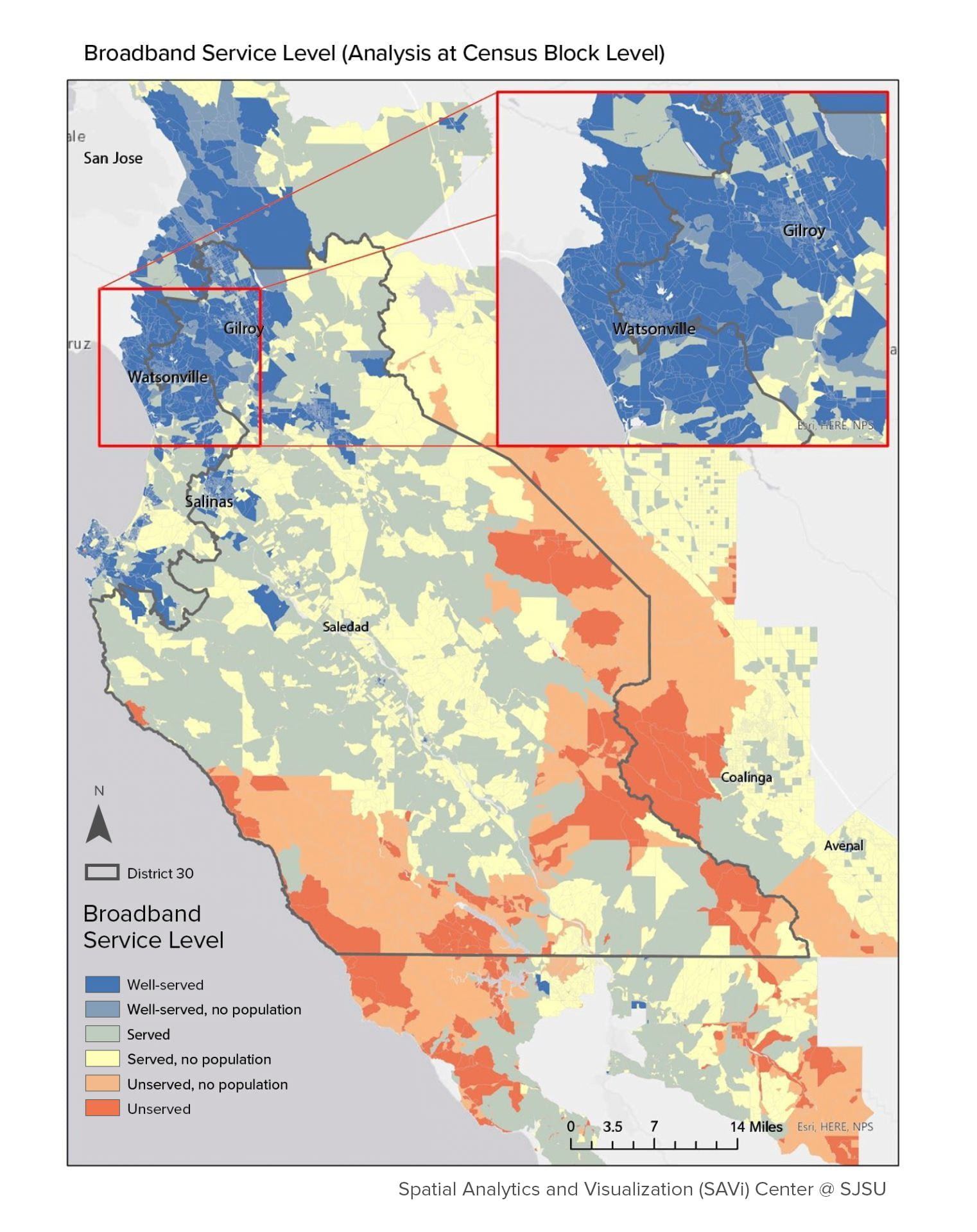California Assemblymember Rivas taps SJSU to provide data for new broadband legislation
In spring 2020, as schools began to close in-person instruction during the COVID-19 pandemic, California Assemblymember Robert Rivas, ’11 MPA, saw how “blatant” limited access to broadband Internet was negatively impacting families in his district—Assembly District 30, which spans from Morgan Hill to King City.
As a native of California’s central coast and an alumnus of San José State, Rivas hoped that by collaborating with faculty members to collect data in the region, the state Legislature would benefit from scientific information to help address the lack of broadband access in the state.
“COVID-19 has exposed and exacerbated the broadband inequities that have existed in our state for years,” said Rivas.
Shortly after, a conversation with San José State Provost and Senior Vice President for Academic Affairs Vincent Del Casino, Jr., sparked an opportunity for Rivas to gather data that could support potential legislation to improve broadband access.
Heather Lattimer, dean of the Lurie College of Education, recommended that Assistant Professors of Teacher Education Luis Poza, Tammie Visintainer and Eduardo Muñoz-Muñoz collaborate to create a case study about the lack of broadband access in the coastal town of Watsonville. Together, the faculty partnered with teachers at Watsonville High School’s Education, Community, Humanitarian, Outreach (ECHO) Leadership Academy to create curriculum that involved high schoolers in the data collection process.
The project sought to answer a few key questions: How could students attend online school with limited Wi-Fi? How could residents access telehealth services without reliable Internet? And how did the pandemic shed light on infrastructure inequities across California?
Mapping Inequity
Students interviewed members of their communities about their Wi-Fi access since the pandemic began in March 2020. Poza and Visintainer presented the resulting case study, along with a series of maps created by the SJSU Spatial Analytics and Visualization (SAVi) Center, led by Assistant Professor of Urban Planning Ahoura Zandiatashbar, that depicted broadband access by demographic across District 30.
“Now that both jobs and education are increasingly relying on high-quality Internet access, the lack of Internet access means a barrier to the upward mobility of residents,” said Zandiatashbar. 
The maps specifically use American Community Survey 2018 data to highlight school-age children, Hispanic and African-American populations, as well as residents with below-poverty earnings. The SAVi team also used Fixed Broadband deployment data released by the Federal Communication Commission to identify four types of broadband service available.
Early analysis revealed that communities with a higher proportion of vulnerable households live in areas with lower broadband access fixed services.
“Our work shows that the neighborhoods of these individuals are suffering from insufficient service providers or the provided service is at a low speed,” explained Zandiatashbar.
“The fact that this region has had issues with Internet access has less to do with the Internet itself, but rather the populations affected,” said Muñoz-Muñoz. “Our racial identities connect with how we speak and choose to communicate, so these inextricable issues make it a social justice matter, a racial matter, a linguistic matter, and a right to learn matter.”
According to Poza, Internet access is not an all-or-nothing issue. A household might have to share wireless accounts across multiple families, which affects speed and reliability. Slow connectivity, in turn, makes it difficult for students to download resources and upload completed assignments.
This was acutely demonstrated when Monterey County Supervisor Luis Alejo tweeted an image of two young girls sitting outside Taco Bell with laptops in August of 2020, attempting to attend online school by accessing the restaurant’s Wi-Fi. The picture went viral, epitomizing the height of the digital divide.
“That photo captured this inequity at its core,” said Rivas. “Low-income families of color are facing the brunt of this pandemic, and it is research like San José State’s broadband report that informs our legislative response to this digital divide through data and facts.”
“Many of the participants mentioned the psychological and mental health costs of managing all this during a pandemic,” said Visintainer. “These kids are often portrayed as students who don’t care or aren’t motivated, but it’s very obvious that’s not the case and that they’re fighting so much harder to just access school right now, much less learn.”
From Research to Legislation
Poza and Visintainer were allotted five minutes with Rivas to explain how unequal access to Internet hotspots was just one way that the pandemic had amplified issues across the region. Central to their argument was that adding broadband infrastructure alone would not address the issues these communities experienced.
“Working with the ECHO Academy students, working with their teachers and hearing from their families and community members, made it abundantly clear that they are as brilliant, motivated and dignified as anyone in Silicon Valley,” said Poza.
“Their lack of access to broadband, housing or financial insecurity or their disproportionate exposure to COVID-19 risk are the results of policy decisions underlying these Band-Aid fixes around infrastructure in years past.”
How can policymakers and education researchers move beyond the Band-Aid? While there is no single cure for social, racial and economic inequity, this collaboration between the Lurie College and Assemblymember Rivas’ office is one critical step in closing the digital divide.
This was made clear in December, when Asm. Cecilia Aguiar-Curry, ’84 Accounting, introduced Assembly Bill 14, which Rivas co-authored, in the California Legislature. The bill, nicknamed the “Internet for All Act of 2021,” would allow educational agencies to report on issues with Internet access as it affects student learning.
“As a graduate of San José State, I am excited to work with the university community,” said Aguiar-Curry. “I know how educational, or anchor institutions, as they are defined in my AB 14, are critical hubs for learning and community engagement. We need the support of every educational, health and public safety institution in California so we can deliver 21st-century Internet technology to all Californians now.”
In the end, the 175 ECHO Academy students who participated in the project with the Lurie faculty had the satisfaction of knowing that the data they collected could lead to positive change not only in their hometown but also across the region. While their contributions could support Rivas’ campaign to improve wireless access, the project empowered students to reflect on pre-existing inequalities that have been exacerbated by the pandemic and what steps they could take to address them.



